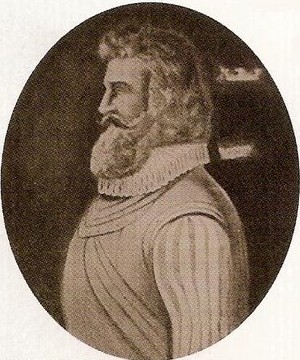Pedro Teixeira facts for kids
Quick facts for kids
Pedro Teixeira
|
|
|---|---|
 |
|
| Born | Late 16th century Cantanhede, Kingdom of Portugal
|
| Died | 4 July 1641 |
| Nationality | Portuguese |
| Occupation | Explorer |
| Known for | second European to travel up the entire length of the Amazon River, after Orellana |
Pedro Teixeira was a brave Portuguese explorer. He lived a long time ago, in the 1600s. In 1637, he became the first European to travel all the way up the Amazon River. This was a huge and dangerous journey!
Pedro Teixeira was born in a place called Cantanhede. We don't know exactly when he was born. His amazing trips were very impressive, even for today. Because of Teixeira, Portugal gained more land in South America. This was more than the Treaty of Tordesillas had given them in 1494. Local people called him Curiua-Catu. This means The Good and Friendly White Man.
Contents
Pedro Teixeira: The Amazon Explorer
The Big Amazon Journey in 1637
In 1637, two Franciscan priests left their mission. They were worried about nearby native groups. With six soldiers, they paddled a canoe up the Amazon River. They reached the main Portuguese town, Fort Presépio (Belem).
Their arrival made the Portuguese wonder. How far east had the Spanish settled the Amazon? At this time, both Spain and Portugal were ruled by Philip IV of Spain. But they still competed a lot for trade. Portugal also wanted to be independent again. This happened in 1640.
So, the governor of Maranhão, Jácome Raimundo de Noronha, quickly planned a trip. He put Captain Pedro de Teixeira in charge.
Teixeira already knew the Amazon very well. He had explored the Xingu River too. He had led trips to remove English and Dutch traders. One of the priests, Andres de Toledo, went to Lisbon. He told the Portuguese leaders about his journey.
Teixeira became the first European to travel up the Amazon River. He reached Quito by using the Napo River. His trip was very big. It had 47 canoes. About 1,200 Native Amazonians and enslaved Africans paddled them. They carried 70 armed Portuguese soldiers. They also had food, weapons, and goods to trade.
Feeding so many people for months was hard. The explorers had to hunt, fish, and gather food. They often traded with local tribes. The Native Amazonians knew a lot about the forest and river. This knowledge was key to the trip's success. Traveling upstream against the strong current was tough. Small groups went ahead to scout the way. They found the right river paths to take. Teixeira also had trouble keeping the Native Amazonians with him. They wanted to go back home as they got farther away.
During the trip, Pedro Teixeira explored the mouth of the Rio Negro. He also found the Madeira River. He explored its lower part and named it. The Madeira River and its connected rivers, the Mamoré and Guaporé, became important. They helped António Raposo Tavares on his big journey from 1648 to 1652.
After eight months, the expedition reached the first Spanish town. This was on the Rio Quijos. Teixeira split his group here. Eight canoes went ahead. The rest stayed at the town for the return trip. The Rio Quijos was too strong to continue by canoe. The rest of the journey was done on foot. After almost a year, in 1638, the group reached Quito. They received a big welcome.
Returning Home in 1638
The Spanish in Peru were very kind to the Portuguese explorers. But they wanted to know how much of the Amazon the Portuguese had settled. Based on the Treaty of Tordesillas from 1494, the Spanish thought the Amazon was theirs. Also, Francisco de Orellana had explored it first.
So, Teixeira and his group stayed in Quito for weeks. The Spanish leaders decided what to do. They chose to send a group of Jesuit priests with them. Cristóbal de Acuña led this group. They would go back with the Portuguese. They would report everything they saw. Father Cristóbal was to give his report to the Royal Council of the Indies.
Father Cristobal's report was published as a book in 1641. In it, he wrote great things about the Amazon regions. He especially praised the native Brazilian people and their way of life. The trip back seemed calm. There was one disagreement. The Jesuits and Portuguese officers argued about a plan. It was about a slaving trip up the Rio Negro. Teixeira agreed with the Jesuits about not slaving. The group finally reached Belém on December 12, 1639. This was just over two years after they started.
Father Cristóbal told Spain to quickly settle the Amazon. But his advice came too late. In 1640, King João IV became king of Portugal. In 1641, the Portuguese in Brazil also recognized him as their king.
We don't know much about Pedro Teixeira after the Amazon trip. After finishing the journey, he went to São Luís do Maranhão. He gave his report to the governor. He was promoted to Capitão-Mor. He became governor of Pará on February 28, 1640. But he left the job after three months because he was sick. He died on July 4, 1641.
See also
 In Spanish: Pedro Teixeira (militar) para niños
In Spanish: Pedro Teixeira (militar) para niños

